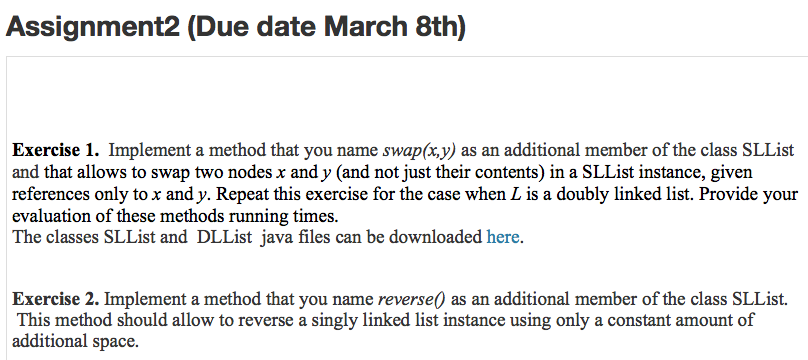Question
DLL LIST CLASS package ods; import java.util.AbstractSequentialList; import java.util.ListIterator; /** * An implementation of the List interface as a doubly-linked circular list. A * dummy

DLL LIST CLASS
package ods;
import java.util.AbstractSequentialList; import java.util.ListIterator;
/** * An implementation of the List interface as a doubly-linked circular list. A * dummy node is used to simplify the code. * * @author morin * * @param
/** * The dummy node. We use the convention that dummy.next = first and * dummy.prev = last */ protected Node dummy;
public DLList() { dummy = new Node(); dummy.next = dummy; dummy.prev = dummy; n = 0; }
/** * Add a new node containing x before the node p * * @param w * the node to insert the new node before * @param x * the value to store in the new node * @return the newly created and inserted node */ protected Node addBefore(Node w, T x) { Node u = new Node(); u.x = x; u.prev = w.prev; u.next = w; u.next.prev = u; u.prev.next = u; n++; return u; }
/** * Remove the node p from the list * * @param w * the node to remove */ protected void remove(Node w) { w.prev.next = w.next; w.next.prev = w.prev; n--; }
/** * Get the i'th node in the list * * @param i * the index of the node to get * @return the node with index i */ protected Node getNode(int i) { Node p = null; if (i i; j--) p = p.prev; } return p; }
public ListIterator
public int size() { return n; }
public boolean add(T x) { addBefore(dummy, x); return true; }
public T remove(int i) { if (i n - 1) throw new IndexOutOfBoundsException(); Node w = getNode(i); remove(w); return w.x; }
public void add(int i, T x) { if (i n) throw new IndexOutOfBoundsException(); addBefore(getNode(i), x); }
public T get(int i) { if (i n - 1) throw new IndexOutOfBoundsException(); return getNode(i).x; }
public T set(int i, T x) { if (i n - 1) throw new IndexOutOfBoundsException(); Node u = getNode(i); T y = u.x; u.x = x; return y; }
public void clear() { dummy.next = dummy; dummy.prev = dummy; n = 0; }
class Iterator implements ListIterator
/** * The node whose value is returned by next() */ Node p;
/** * The last node whose value was returned by next() or previous() */ Node last;
/** * The index of p */ int i;
Iterator(DLList
public boolean hasNext() { return p != dummy; }
public T next() { T x = p.x; last = p; p = p.next; i++; return x; }
public int nextIndex() { return i; }
public boolean hasPrevious() { return p.prev != dummy; }
public T previous() { p = p.prev; last = p; i--; return p.x; }
public int previousIndex() { return i - 1; }
public void add(T x) { DLList.this.addBefore(p, x); }
public void set(T x) { last.x = x; }
public void remove() { if (p == last) { p = p.next; } DLList.this.remove(last); }
} }
SLL LIST CLASS
package ods;
import java.util.AbstractQueue; import java.util.Iterator; import java.util.Queue;
/** * An implementation of a FIFO Queue as a singly-linked list. * This also includes the stack operations push and pop, which * operate on the head of the queue * @author morin * * @param
public SLIterator() { p = head; } public boolean hasNext() { return p != null; } public T next() { T x = p.x; p = p.next; return x; } public void remove() { throw new UnsupportedOperationException(); } } return new SLIterator(); }
@Override public int size() { // TODO Auto-generated method stub return n; }
public boolean add(T x) { Node u = new Node(); u.x = x; if (n == 0) { head = u; } else { tail.next = u; } tail = u; n++; return true; } public boolean offer(T x) { return add(x); }
@Override public T peek() { return head.x; }
public T poll() { if (n == 0) return null; T x = head.x; head = head.next; if (--n == 0) tail = null; return x; } /** * Stack push operation - push x onto the head of the list * @param x the element to push onto the stack * @return x */ public T push(T x) { Node u = new Node(); u.x = x; u.next = head; head = u; if (n == 0) tail = u; n++; return x; } protected void deleteNext(Node u) { if (u.next == tail) tail = u; u.next = u.next.next; } protected void addAfter(Node u, Node v) { v = u.next.next; u.next = v; if (u == tail) tail = v; } protected Node getNode(int i) { Node u = head; for (int j = 0; j
/** * Stack pop operation - pop off the head of the list * @return the element popped off */ public T remove() { if (n == 0) return null; T x = head.x; head = head.next; if (--n == 0) tail = null; return x; } public T pop() { if (n == 0) return null; T x = head.x; head = head.next; if (--n == 0) tail = null; return x; }
public static void main(String[] args) { Queue } }
Step by Step Solution
There are 3 Steps involved in it
Step: 1

Get Instant Access to Expert-Tailored Solutions
See step-by-step solutions with expert insights and AI powered tools for academic success
Step: 2

Step: 3

Ace Your Homework with AI
Get the answers you need in no time with our AI-driven, step-by-step assistance
Get Started


